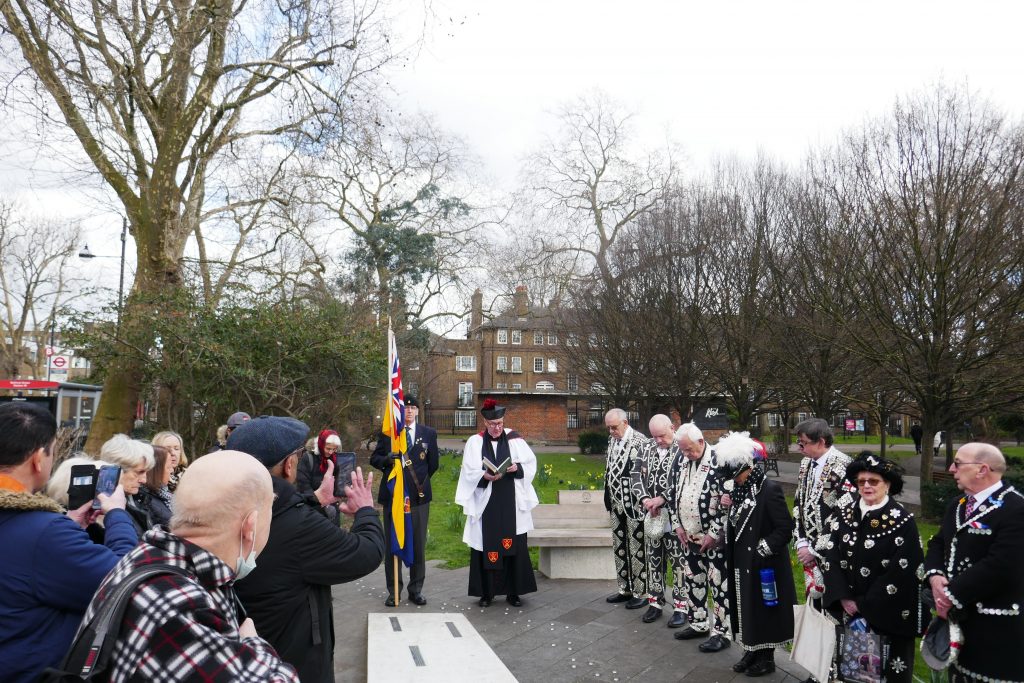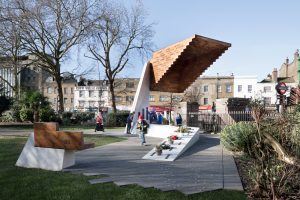
On 3rd March 1943 the siren sounded at 8.17pm. People made their way in the pitch dark of the blackout to file in an orderly manner down the steps to the unfinished Bethnal Green underground station, which had been used as an air-raid shelter since 1940. At 8.27pm the searchlight went on and 3 buses unloaded their passengers at the shelter entrance. Suddenly those waiting to enter the single, narrow doorway heard the unfamiliar, deafening sound of a brand new anti-aircraft rocket batter firing nearby. Never having heard it before they assumed it was deadly enemy bombs exploding. At that same moment a woman with a baby fell at the bottom of the wet, slippery stairway pulling an elderly man down with her. Before they could get up others fell on top of them. The crowd above continued pressing forward, unable to see what was happening below in the dark. With more people falling on top of them a complete jam of about 300 people, five or six deep, built up within seconds between the floor and ceiling. People couldn’t move, pinned down by the weight of those above them – and then they couldn’t breathe. It was 11.40pm before the last person was pulled out. By then 173 were dead – 84 women, 62 children and 27 men. Over 90 were injured. Many more suffered life-long trauma, particularly the rescuers, from the dreadful experience.
The Bethnal Green tube shelter disaster turned out to be the worst civilian disaster of the 2nd World War yet no bombs were involved as there was no plane recorded in that part of London that night. The official report (published after the war) revealed that the local Bethnal Green Council had asked the government three times, 2 years earlier, for permission to alter the entrance to make it safer, but had largely been refused. These measures might not have made any difference to the tragedy – we will never know - but they were put in place the day after the disaster.
In the book ‘Mr. Morrison’s Conjuring Tricks’ the author Rick Fountain sets out the evidence of a government cover up. He states that in 1941 the Council had written to the government asking for permission to alter the station entrance and make it safer if a lot of people wanted to use it. The Government department refused and the Borough Engineer wrote a stronger worded letter explaining that the entrance and stairway needed several measures to make them safer. Again the government refused permission. The Council’s borough engineer wrote a third time to plead for permission to alter the entrance, but was largely refused apart from allowing some recycled word to be used to shore up the entrance. The day after the disaster all the measures sought by the Council were put in place. However, Bethnal Green Council was made to keep their earlier letters secret, under the Official Secrets Act. Statements given in Parliament, after the secret official inquiry had taken place, hinted that the victims were to blame. This ensured the event was kept as secret as possible. This was partially to prevent the enemy using it for propaganda purposes and to keep up morale. Apparently, according to the book, it also saved the Home Secretary of the day, Herbert Morrison, from having to resign. The Lady Mayor of Bethnal Green, Margaret Bridger, was not allowed to defend herself and was largely blamed for the tragedy. The sectret official report, and the suming up by the Judge in the one Court case that followed, agreed that there had been no panic on the part of the victims so they were not to blame. The final statement about the report was read out in Parliament by another MP, as Herbert Morrison had a cold on that day, So no questions could be asked. By suggesting that the victims were to blame it was the Hillsborough of its day.
Please click the red button below to donate to the Memorial Fund.
The Memorial Service to mark the 83rd anniversary of the Bethnal Green tube disaster will be held on Sunday 8th March 2026 at St. John on Bethnal Green Church at 2pm. Please ensure that any flowers or wreaths that you wish to place on the Memorial does not have any sharp or metal parts to them as this damages the Memorial.
We held a Memorial Service for the victims that are buried in Manor Park Cemetery on Saturday 27th September. It was beautifully conducted by Rev. Chris Morgan at the side of the new memorial that the cemetery built to honour those that died in the Bethnal Green tube disaster and are buried there. The memorial is closest to the pedestrian entrance on Whitter Road, (no vehicle access), which is a short walk from Manor Park station on the Elizabeth Line.

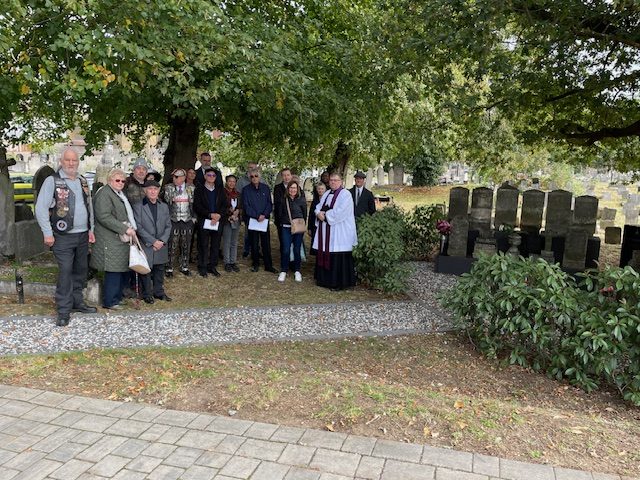
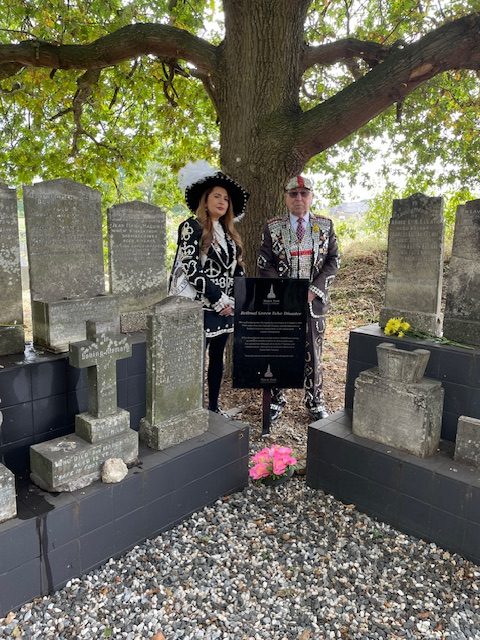
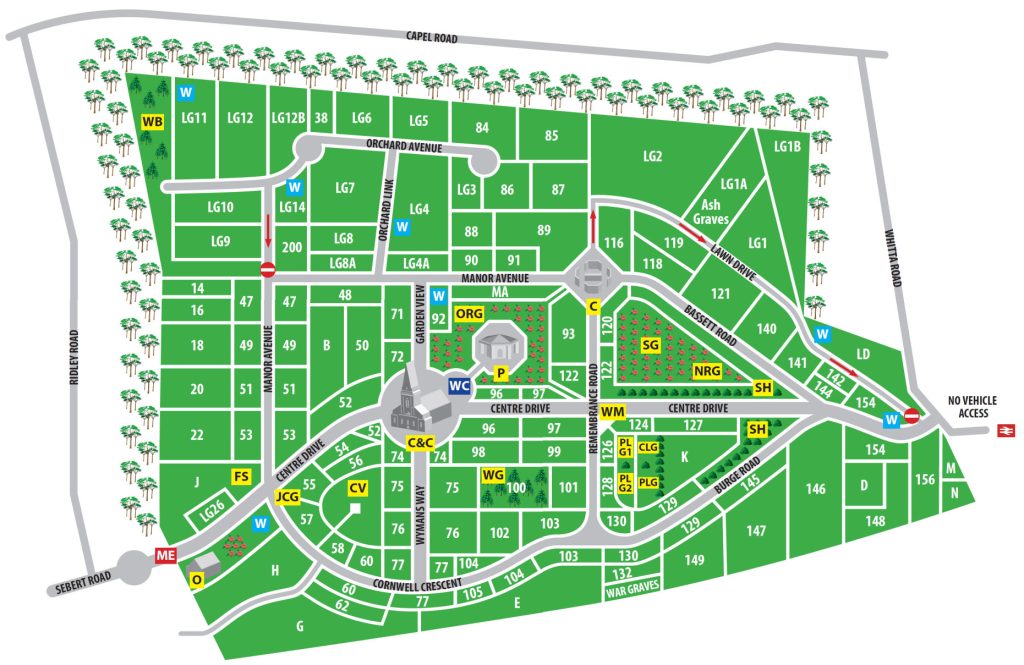
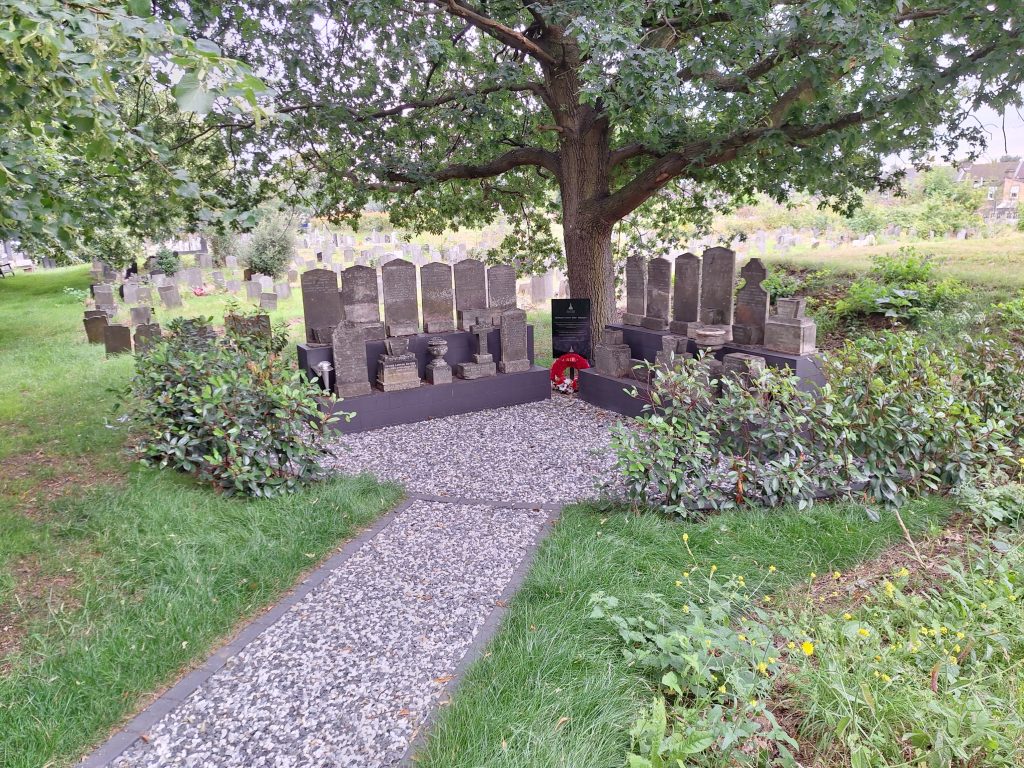
We are still compiling a full biography of each of the victims of the BG tube disaster, as well as survivors and helpers, to pass on to the archives for posterity. So, if you have not already sent us a short biography of your relative (with a photo if possible), please could you do so as soon as possible. We would really like to complete this soon.

We are devastated to learn that disaster survivor Babs Clark has just died at the age of 93. She spent many hours giving talks to school children who loved her sense of fun. Babs and her sister were trapped in the crush on the stairs at Bethnal Green tube in March 1943. They were pulled out eventually but couldn’t find their mum. After searching amongst the bodies, without success, her older sister suddenly found their mum and they all made their way home. Next morning Babs got up and found she was heavily bruised all down one side, but her mum told her that her sister was the same, but she still had to go to school! During the war their house was bombed and part of the roof was just covered with tarpaulin to keep out the cold and rain, not very well apparently. It was that toughness and resilience that helped Babs cope with the loss of her son almost 2 years ago and the extreme pain of arthritis recently. We thank Babs for all the hours she spent talking to pupils about the disaster and bringing the reality of the war, rationing, bombing, etc, alive for them. We also thank Babs for all the hours she spent helping us with fund-raising. Rest in peace now Babs. We will miss you lots, especially your smile. Much love from us all on the charity committee and everyone that knew you.

THE 82nd ANNIVERSARY MEMORIAL SERVICE 3 MARCH 2025
The sun shone on us for the Memorial Service (below)to commemorate the 82nd anniversary of the Bethnal Green tube shelter disaster on 3rd March. The newly cleaned memorial was gleaming when Rev Philippa Cook opened the Service and relatives read out the 173 victims’ names between them. Survivors, victims and rescuers were remembered in our prayers during the lovely Service and a Hebrew prayer was also read out by Martin Sugarman for the few Jewish victims. A minute’s silence was held and even the traffic seemed to stay relatively quiet at that time. It was lovely to see so many of our family members, survivor Ray Lechmere, supporters and Pearly Kings & Queens, joining us for the event. The beautiful flowers and wreaths laid on the Memorial paid tributes to loved ones. It was an emotional day, but so good to be able to honour and remember all those involved in the worst civilian disaster of World War 2 now that the fence has been pushed to the back.









MEMORIAL SERVICE AT MANOR PARK CEMETERY 24TH NOVEMBER 2024
Relatives of the victims who died in the Bethnal Green Tube Disaster and are buried at Manor Park Cemetery gathered on Sunday 24th November to honour them with a Memorial Service at the Cemetery. Due to storm Bert, the high winds on the day meant the cemetery had to be closed due to safety concerns. However, the cemetery kindly allowed our relatives in so that the beautiful service could go ahead in the chapel, led by Rev. Moira McCutcheon, Rector of Christ Church, Spitafields. The names of all 88 buried at the cemetery were read out by some of their relatives.
Back in 2000, Manor Park Cemetery put up notices announcing that the area containing the graves of many of those who had died in the Disaster was to be levelled and mounded up to create space for more burials. Some of the gravestones were rescued and others were relocated by their relatives.
Following a long campaign by local historian Ben Priestley, backed by us, the cemetery agreed to produce a new fitting memorial to include our victims and their gravestones to create a new space for remembrance. We were able to lay wreaths and flowers at the memorial, but due to the high winds they had to be wedged in so they did not blow away! It was a lovely and comforting event for all those present and we might consider making it an annual event.








THE COMMEMORATION SERVICE MARCH 2024
The Commemoration Service to mark the 81st Anniversary of the Bethnal Green tube disaster took place on 3rd March 2024 at the Memorial itself. Rev. Jordan Prance took the service with a number of prayers and then several relatives and committee members read out the names of the 173 victims. There was also a minute's silence to remember everyone involved in the disaster before wreaths and flowers were laid. It was a very moving service and lovely to see so many people present in the warm sunshine. It was also great to see members of the local fire service and police plus the wonderful Pearly Kings & Queens there to help us honour the worst civilian disaster of World War 2. Unfortunately there is still a fence around the memorial as the local council is planning to undertake maintenance work soon. We will let you know when it has been removed and we will then be able to give the Memorial a good spring clean.


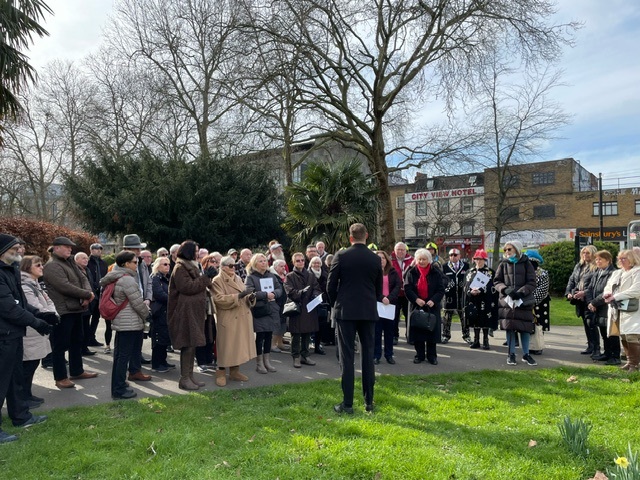

The 80th Anniversary Memorial Service of the Disaster 5th March 2023


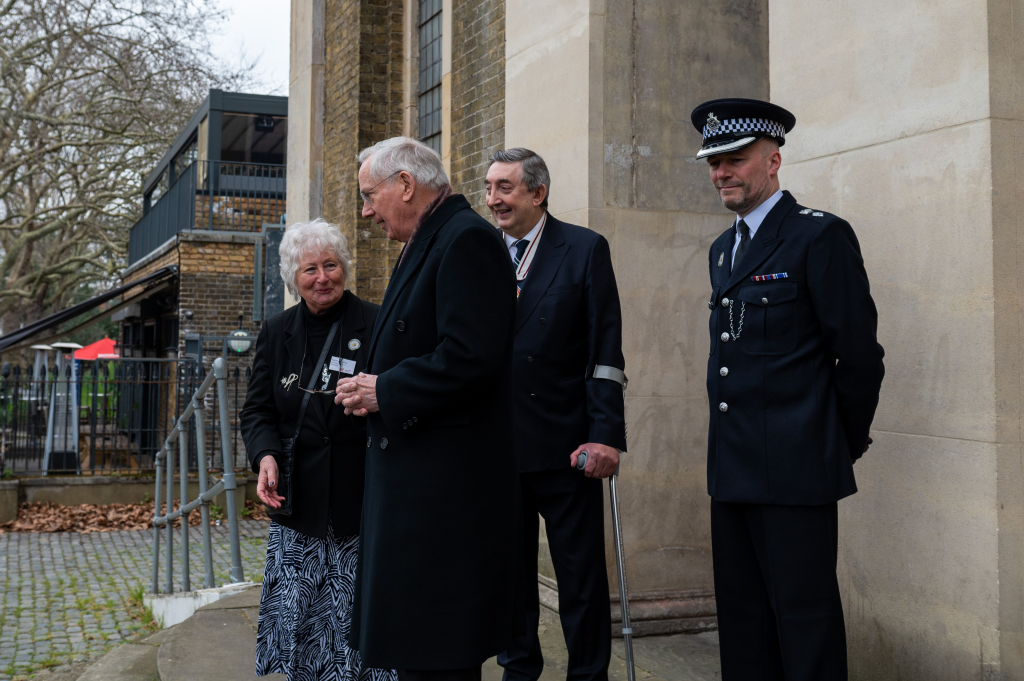
Survivors and Relatives Remember The Worst Civilian Disaster of WW2.
Over 300 people packed St. John on Bethnal Green Church on Sunday to mark the 80th anniversary of the Bethnal Green tube shelter disaster – the worst civilian disaster of WW2 not caused by enemy bombs. The service was led by the Bishop of Stepney, The Rt Rev Dr Joanne Grenfell who gave a comforting address, along with Fr Brian Ralph (St. Barnabas Church) and Revd Christopher Morgan (Chaplain to the Bishop of Stepney).
In the front pew at the church was HRH, The Duke of Gloucester; the Deputy Lieutenant of Tower Hamlets Leslie Morgan as well as local MP Rushanara Ali and several representatives from Tower Hamlets Council, including the deputy mayor Maium Talukdar. During the service the names of all 173 victims were read out by members of the Stairway to Heaven Memorial Trust committee, many of whom had family that died in the disaster. At the same time 173 candles were lit on the altar. HRH delivered a very moving Bible reading. Committee Chairman Joyce Hampton read out her own poignant poem ‘Looking Down On You and Me’.
For more details please go to our page 2023 Events
The 79th anniversary Memorial Service for the Bethnal Green tube shelter disaster was even more emotional this year. Whilst the names of the victims were read out (mostly by members of their family), 173 candles were lit on the altar to represent them. Fr. Alan Green, Rector of St. John’s Church, spoke of the 173 lives lost trying to seek safety in the underground shelter at Bethnal Green tube station in 1943. In remembering them, he said, that we had hoped that nothing like it would ever happen again. Yet here we are today, with thousands of people seeking safety in shelters in Ukraine. He quoted the Dalai Lama as saying ‘Never Give Up. No Matter What Is Going On’ and asked us also to also pray for those suffering in Ukraine. We hope that our prayers will help keep many safe during these heart-breaking times.
Secretary of the Stairway to Heaven Memorial Trust, Sandra Scotting, reported their additional sadness as: “Two of our survivors had died in the last year – Margaret McKay and Joseph Walker. Margaret was the youngest survivor, whose mother, Ellen Ridgway, was trapped in the crush. She passed baby Margaret to a policeman to take her out of the station to safety, but by the time he returned Ellen was dead. It was good to see other survivors though, in particular George Johnson aged 92, attending the service for the first time”.
Sandra also announced that next year, the 80th anniversary of the disaster, would be the last time a Memorial Service would be organised here in the church after 15 years of the charity doing so. After that, everyone would be welcome to come to the Memorial itself on the actual anniversary – 3rd March – for a blessing instead. So, it was hoped that as many people as possible will join us for the 80th anniversary Memorial Service on Sunday 5th March next year at 2pm, to ensure it will be a memorable event to finish on.
After the Service Nick Ridsdale carried the CDA standard, leading the parade across the road to the Memorial for a blessing and a minute’s silence. He was joined by several Pearly Kings & Queens, relatives of the victims, plus survivors and local MP Rushanara Ali, Mayor of Tower Hamlets John Biggs and local councillors. Firefighters from the local Bethnal Green Fire Station formed a guard of honour at the side of the Memorial. After this everyone returned to the church for refreshments and to share their stories and experiences. The drinks were provided by the wonderful staff of Starbucks from across the road and they plus members of the charity committee and other supporters had supplied the cakes.

